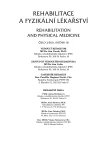EMG Analysis of Selected Muscles of the Lower Extremities and Back Muscles during Cycling in Water and on Land
Authors:
H. Sladká; D. Pavlů; D. Pánek
Authors‘ workplace:
Katedra fyzioterapie FTVS UK, Praha, vedoucí katedry doc. PaedDr. D. Pavlů, CSc.
Published in:
Rehabil. fyz. Lék., 18, 2011, No. 3, pp. 126-131.
Category:
Original Papers
Overview
In this experiment the relationship between muscles of lower extremities/back muscles and air/water was processed and analyzed. The main goal was to compare timing of muscles of lower extremities (m. biceps femoris, m. gastrocnemius lateralis, m. vastus medialis, m. tibialis anterior) and of back muscles (mm. paravertebrales dx. a mm. paravertebrales sin. in lumbal spine) during cycling on land and in water. The same aqua bike Sapilo was used for both environments. Timing of muscles is similar for both environments. The influence of water was reflected in the speed of pedaling and in the level of muscle activity.
Key words:
surface electromyography, Water Surface EMG, timing, aqua bike
Sources
1. HAMILL, J., KNUTZEN, K. M.: Biomechanical basis of human movement. 3. vydání, místo neznámé: The Point, 2009.
2. HUG, F., DOREL, S.: Electromyographic analysis of pedaling: A review. Journal of Electromyography and Kinesiology, 2009, č. 19, s. 182-198.
3. KANEDA, K. et al.: EMG activity of hip and trunk muscles during deep-water running. Journal of Electromyography and Kinesiology, 2009, č. 19, s. 1064-1070.
4. KRAČMAR, B., BAČÁKOVÁ, R., HOJKA, V.: Vliv cyklistického kroku na pohybovou soustavu. Rehabilitace a fyzikální lékařství, 2010, č. 3, s. 107-112.
5. MASUMOTO, K. et al.: Electromyographic Analysis of Walking in Water in Healthy Humans. Journal of Physiological Anthropology and Applied Human Science. 2004, č. 23, s. 119-127.
6. MASUMOTO, K. et al.: Muscle activity and heart rate response during backward walking in water and on dry land. European Journal of Applied Physiology, 2005, č. 94, s. 54-61.
7. MASUMOTO, K., DELION, D., MERCER, J. A.: Insight into muscle Activity during deep water running. Medicine and Science in Sports and Exercise, 2009, s. 1958-1964.
8. MIYOSHI, T. et al.: Functional roles of lower-limb joint moments while walking in water. Clinical Biomechanics, 2004, č. 12, s. 194-201.
9. NITKA, R.: EMG analýza zádových svalů při různých variantách sedu. Praha, 2009. 89 s. Diplomová práce na Fakultě tělesné výchovy a sportu Univerzity Karlovy. Vedoucí diplomové práce Dagmar Pavlů.
10. PÁNEK, D. et al.: Metodika snímání povrchového EMG ve vodním prostředí. Rehabilitace a fyzikální lékařství, 2010, č. 1, s. 21-25.
11. ROUFFET, D. M. et al.: Timing of mucle activation of the lower limbs can be modulated to maintain a constant pedaling cadence. Journal of Electromyography and Kinesiology. 2009, č. 19, s. 1100-1107.
12. SHONO, T. et al.: Gait patterns and muscle activity of the lower extremities of elderly women during underwater treadmill walking against water flow. Journal of Physiological Anthropology. 2007, č. 26, s. 579-586.
13. SLADKÁ, H.: Porovnání timingu svalů při jízdě na kole ve vodě a na suchu. Praha, 2011. 76 s. Diplomová práce na Fakultě tělesné výchovy a sportu Univerzity Karlovy. Vedoucí diplomové práce Dagmar Pavlů.
14. VENEZIANO, W. H. et al.: Confouding factors in water EMG recordings: an approach to a definitive standard. Medical and Biological Engineering and Computing. 2006, č. 44, s. 348-351.
Labels
Physiotherapist, university degree Rehabilitation Sports medicineArticle was published in
Rehabilitation & Physical Medicine

2011 Issue 3
Most read in this issue
- Chest Expansion, Ventilatory Parameters and Selected Kinesiologic Indices in Patients with Bronchial Asthma and Chronic Obstructive Disease
- Therapy and Training with Vibrations: Acctual Trend or Effectives Procedures?
- Results of the Investigation Among Participants of the Course in „Diagnostics and Pain Management in Rehabilitation”
- Statistical Evaluation of Treatment Efficiency in Pain Conditions of Lumbosacral Region
